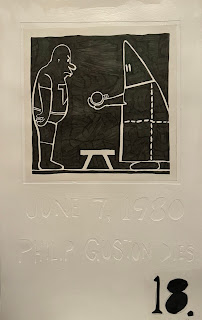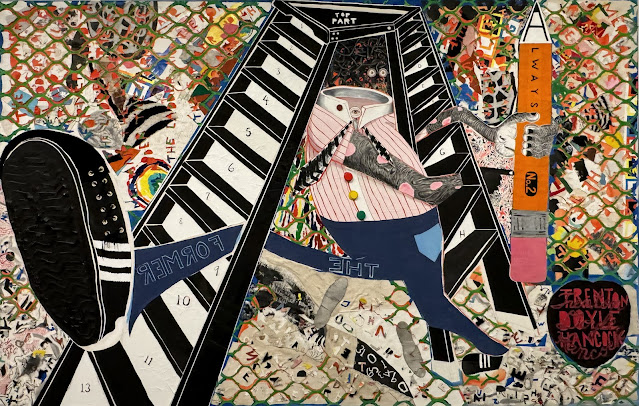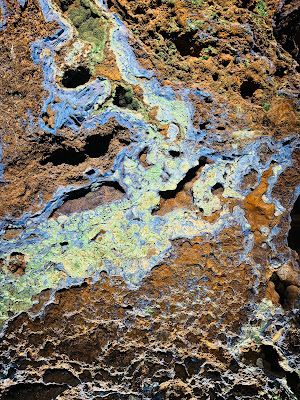It's been said "Never meet your heroes." Or read long, detailed biographies about them, either.
Will Hermes obviously spent a lot of time interviewing musicians and reviewing
Reed's archives at the New York Public Library; if nothing else,
Lou Reed: The King of New York offers the textual equivalent of a lifelong stan's voluminous scrapbook. It thoroughly documents every phase of his life.
But is asking a biographer to offer some considered judgment about his subject too much? What made Lou such an asshole? It can't just have been his less-than-affectionate father or shock treatments in the early 60s.
Transformer brought me to Lou my sophomore year in college; I loved "
Perfect Day" and "
Satellite of Love" almost as much as "
Walk on the Wild Side." The singer-songwriter's gay vibe contributed to the album's allure as much as the music and transgressive art work (Hermes reveals that the male model on the back cover stuffed a banana in his jeans).
Rock and Roll Animal, one of the few live albums I ever have loved, sealed the deal for this young fan, still struggling with his own sexuality. Not only did it introduce me to Lou's greatest work with the
Velvet Underground; the buzzcut, lipstick and leather-encased crotch blew my mind. This (sexy) renegade isn't kidding!
But maybe he was, or perhaps my understanding of human sexuality is too binary. He did, after all, end up marrying three women, two of whom contributed more to his mental health and career than anybody else, as Hermes makes amply clear. Perhaps only Sylvia Morales or
Laurie Andersen are able to provide the insight I crave and it would be fully understandable if they said "mind your own fucking business!" Lou certainly would have, although if
Duncan Hannah's claim is accurate--here dismissed as a goof--perhaps ignorance
is bliss.
I stuck with Lou for more than a decade. With the exception of
Metal Machine Music, I bought every subsequent album through
The Blue Mask before deciding he just wasn't my cup of tea any longer. The farther he got away from
Andy Warhol and
David Bowie, the less I liked him. And the book. It doesn't help that when Hermes does offer critical judgment--
In death, as in life, Reed was a few steps ahead of David Bowie--he's dead wrong about the latter.
Lou Reed: The King of New York proves that few people in rock 'n roll sneered better or behaved worse ("King of Self Sabotage" would have been a more accurate subtitle). But my time would have been better spent listening to "
Coney Island Baby," arguably the song that struck the greatest chord with this listener, on repeat. At least I have Hermes to thank for solving the mystery of Rachel.
You know, man, when I was a young man in high school
You believe in or not, that I wanted to play football for the coach
And all those older guys
They said that he was mean and cruel but you know
I wanted to play football, for the coach
They said I was a little too lightweight to play lineback and so I'm playing right-end
Wanted to play football for the coach
'Cause, you know some day, man you gotta stand up straight unless you're gonna fall
Then you're going to die
And the straightest dude I ever knew was standing right for me, all the time
So I had to play football for the coach
And I wanted to play football for the coach
When you're all alone and lonely
In your midnight hour
And you find that your soul
It has been up for sale
And you're getting to think about
All the things that you done
And you're getting to hate
Just about everything
But remember the princess who lived on the hill
Who loved you even though she knew you was wrong
And right now she just might come shining through
And the
Glory of love
Glory of love
Glory of love, just might come through
And all your two-bit friends have gone and ripped you off
They're talking behind your back saying "man, you are never going to be no human being"
And you start thinking again about all those things that you've done
And who it was and what it was
And all the different things that made every different scene
Ah, but remember that the city is a funny place
Something like a circus or a sewer
And just remember, different people have peculiar tastes
And the
Glory of love
The glory of love
The glory of love, might see you through
Yeah, but now, now
Glory of love
The glory of love
The glory of love might see you through
Glory of love, uh, huh-huh
The glory of love
Glory of love, glory of love
Glory of love, now, glory of love, now
Glory of love, now, now, now, glory of love
Glory of love, give it to me now, glory of love to see you through, huh
Oh, my Coney Island baby, now
I'm a Coney Island baby, now
I'd like to send this one out to Lou and Rachel
And all the kids at P.S. one-ninety-two (Coney Island baby)
Man, I'd swear, I'd give the whole thing up for you



















































